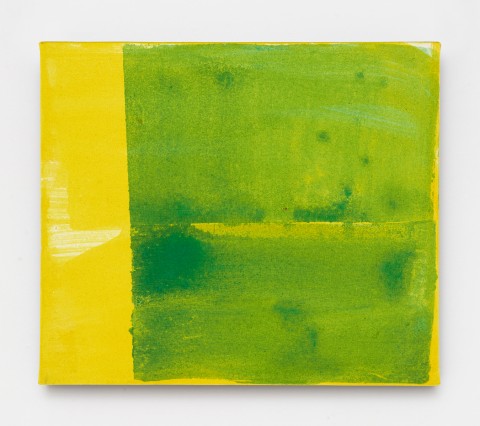Backstage Landscape as Vision
Acrylic, lacquer and fake wound on board, framed
53,5 cm × 43,5 cm I 21 × 17 in
Gelatin silver print, collage, artist´s frame
55 × 43 cm I 21 2/3 × 17 in
BACKSTAGE is a new format within which Galerie Guido W. Baudach will from now on regularly highlight special individual works and series by one or thematically selected works by various artists, independently of the regular exhibition program and both purely physically in the gallery's showroom and virtually online on the gallery’s website.
The prelude, entitled Landscape as Vision, gathers a compilation of works that, despite partly differing genres, formulate a similarly surreal-abstract conception of the common subject. This first BACKSTAGE presentation, featuring works by Tamina Amadyar, Andy Hope 1930, Erwin Kneihsl and Thomas Zipp, will be on view from February 18 to March 20, 2021.
Tamina Amadyar's quite early painting malibu, 2015, appears as an almost minimalist interpretation of the Pacific horizon northwest of Los Angeles, a seascape in which the sunny yellow prevailing on site meets the rich leafy green of the neighboring hinterland of the same name instead of the actual blue shades of the sky and the sea.
The combine painting An Impossible Place, 2018, by Andy Hope 1930, on the other hand, describes a pure fantasy landscape that appears entirely artificial or cartoonish, and in which the sky, possibly in reminiscence of environmental destruction and ozone leakage, has a gaping wound in the form of a corresponding dummy from the costume and novelty stores.
The photographic work Super Windrad 1, 2013, by Erwin Kneihsl, in turn, typically executed as a classic black-and-white hand print, which is, however, quite unsentimentally tacked onto gray cardboard in punk manner, is based on the photograph of a landscape of the kind that has been increasingly encountered in the mostly flat environs of Berlin for some years now: a wind farm; However, this is not in the sense of a reproduction of the actual conditions that is interested in the documentary, but rather as a transformation of the original motif produced by the deliberate use of photographic and photochemical techniques, which quite involuntarily makes one think of a flower meadow like from a science fiction movie.
In Thomas Zipp's Candy Shop (P.O.R.A.), 2021, landscape appears as a strange hybrid of an extraterrestrial-like atmosphere and the characteristic contours of that low mountain range in southern Hesse from which the artist himself originally hails. In the midst of this scenery, Thomas Zipp plants lollipop-like trees around the gridded cubature of a high-rise facade. Everything in this picture appears structured as well as free and open at the same time; entirely in the sense of Le Corbusier's programmatic manifesto The Poem of the Right Angle, to which the subtitle refers in abbreviated form. – An artist´s work as a candy shop?
BACKSTAGE heißt ein neues Format, innerhalb dessen die Galerie Guido W. Baudach von nun an regelmäßig spezielle Einzelwerke und Serien eines oder thematisch ausgewählte Arbeiten verschiedener Künstler*innen beleuchten wird, unabhängig vom regulären Ausstellungsprogramm und sowohl ganz physisch im Showroom der Galerie als auch virtuell online auf der galerieeigenen Webseite.
Den Auftakt bildet unter dem Titel Landschaft als Vision eine Zusammenstellung von Arbeiten, die trotz teils unterschiedlicher Gattungszugehörigkeit eine ähnlich surreal-abstrakte Auffassung des gemeinsamen Sujets formulieren. Diese erste BACKSTAGE-Präsentation mit Arbeiten von Tamina Amadyar, Andy Hope 1930, Erwin Kneihsl und Thomas Zipp wird vom 18. Februar bis 20. März 2021 zu sehen sein.
Tamina Amadyars recht frühes Gemälde malibu, 2015, erscheint als geradezu minimalistische Interpretation des pazifischen Horizonts nordwestlich von Los Angeles; ein Seestück, bei dem das vor Ort vorherrschende Sonnengelb statt auf die tatsächlichen Blauschattierungen des Himmels und des Meeres auf das satte Blattgrün des benachbarten Hinterlandes gleichen Namens trifft.
Die Malereicollage An Impossible Place, 2018, von Andy Hope 1930 beschreibt dagegen eine reine Fantasielandschaft, die vollkommen künstlich bzw. cartoonhaft wirkt, und bei der der Himmel, möglicherweise in Reminiszenz auf Umweltzerstörung und Ozon-Loch, mit einer klaffenden Wunde in Form einer entsprechenden Attrappe aus dem Kostüm- und Scherzartikelhandel versehen ist.
Die fotografische Arbeit Super Windrad 1, 2013, von Erwin Kneihsl wiederum, typisch ausgeführt als klassischer Schwarz-Weiß-Handabzug, der jedoch ganz unsentimental und in Punk-Manier auf Graupappe aufgetackert ist, basiert auf der Aufnahme einer Landschaft, wie sie im meist flachen Umland von Berlin seit einigen Jahren immer häufiger anzutreffen ist: ein Windpark; dies jedoch nicht im Sinne einer am Dokumentarischen interessierten Wiedergabe der tatsächlichen Gegebenheiten, sondern als eine durch den bewussten Einsatz von fotografischen und fotochemischen Techniken erzeugte Anverwandlung des ursprünglichen Motivs, die ganz unwillkürlich an eine Blumenwiese aus einem Science-Fiction-Film denken lässt.
In Thomas Zipps Candy Shop (P.O.R.A.), 2021 erscheint Landschaft als seltsamer Hybrid von extraterrestrisch anmutender Atmosphäre und den charakteristischen Konturen jenes südhessischen Mittelgebirgslands, aus dem der Künstler selbst ursprünglich stammt. Inmitten dieser Szenerie pflanzt Thomas Zipp Lollipop-artige Bäume um die gerasterte Kubatur einer Hochhausfassade. Alles in diesem Bild wirkt ebenso strukturiert wie gleichzeitig frei und offen; ganz im Sinne von Le Corbusiers programmatischem Manifest The Poem of the Right Angle, auf das der Untertitel in Abkürzung verschlüsselt verweist. – Ein Künstlerbuch als Bonbonladen?




